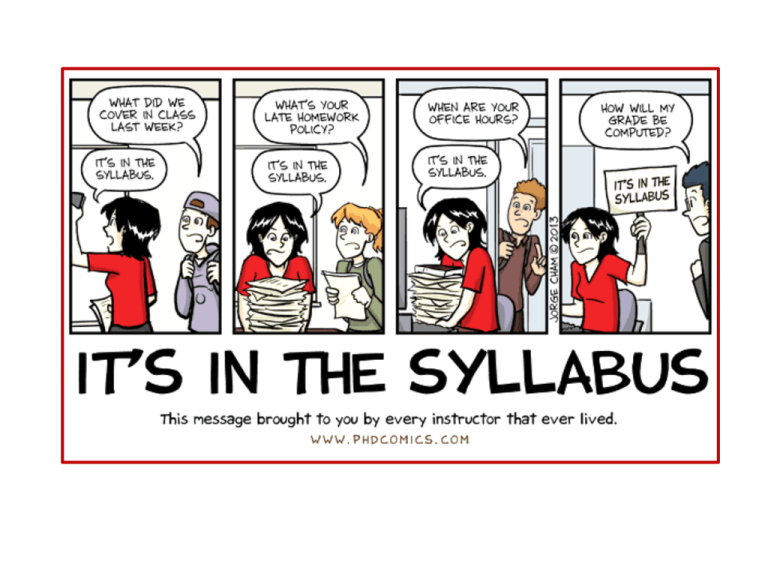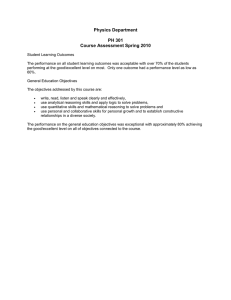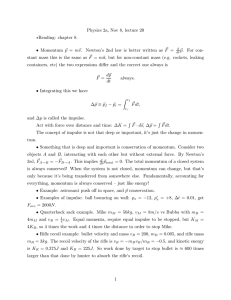Document 14315109
advertisement

Ch. 7: Momentum, Impulse & Collisions THE COURSE THEME: NEWTON’S LAWS OF MOTION! • Chs. 1-5: Motion analysis with Forces. • Ch. 6: Alternative analysis with Work & Energy. – Conservation of Energy: NOT a new law! We’ve seen that this is Newton’s Laws reformulated or translated from Force Language to Energy Language. • NOW (Ch. 7): Another alternative analysis using the concept of (Linear) Momentum. • Ch. 7: Another alternative analysis using the concept of (Linear) Momentum. • Conservation of (Linear) Momentum: NOT a new law! –We’ll see that this is just Newton’s Laws of Motion re-formulated or reexpressed (translated) from Force Language to (Linear) Momentum Language. • Chs. 1-5: Newton’s Laws of Motion using the concepts of position, displacement, velocity, acceleration, force. • Newton’s Laws with Forces: General! • In principle, they could be used to solve any dynamics problem, But, often, they are very difficult to apply, especially to very complicated systems. So, alternate formulations have been developed. They are often easier to apply. • In Ch. 6, we expressed Newton’s Laws using Work & Energy Language. • Newton’s Laws with Work & Energy: These are also general! In principle, they could be used to solve any dynamics problem. But, often, it’s more convenient to use still another formulation. • Now, we’ll be discussing another approach that uses Momentum instead of Energy or Force as the basic physical quantity. • Newton’s Laws in a different language (Momentum). Before we discuss these, we need to learn vocabulary in Momentum Language. Linear Momentum • Momentum: The momentum of an object is DEFINED as: (a vector || v) SI Units: kgm/s = Ns • In 3 dimensions, momentum has 3 components: px = mvx py = mvy pz = mvz • Newton called mv “quantity of motion”. • Question: How is the momentum of an object changed? • Answer: By the application of a force F! Momentum: p = mv Most general statement of Newton’s 2nd Law: ∑F = (p/t) (1) The total force acting on an object = the time rate of change of the object’s momentum. • (1) is more general than ∑F = ma because it allows for the mass m to change with time also! • Example, rocket motion! • Note: if m is constant, (1) becomes: ∑F = (p/t) = [(mv)/t] = m(v/t) = ma Newton’s 2nd Law (General Form!) ∑F = p/t (1) • Suppose that, for a short time t, m = constant Initial Momentum p0 = mv0 Final Momentum p = mv • (1) then becomes: ∑F = p/t = m(v-v0)/t = m(v/t) = ma (as before) Example: Force of a Tennis Serve For a top player, a tennis ball leaves the racket on the serve with speed v2 = 55 m/s (~ 120 mi/h). Assume that v1 = 0 & the ball’s mass is m = 0.06 kg If the ball is in contact with the racket for the short time t = 4 ms (4 × 10-3 s). Estimate The average force Favg on the ball. Would this be large enough to lift a 60-kg person? Solution: v2 = 55 m/s (~ 120 mi/h) v1 = 0, m = 0.06 kg t = 4 ms (4 × 10-3 s). Newton’s 2nd Law: Favg (p/t) & p = m(v2 - v1) So, Favg 800 N To lift a person with mass M = 60-kg, requires a force greater than Mg = (60)(9.8) = 588 N So, yes the calculated force is more than enough to lift such a person!! • Consider an isolated system with 2 masses: m1 moves at velocity v1 & m2 moves at velocity v2. m1 feels a force F21 exerted on it by m2. m2 feels a force F12 exerted on it by m21. See figure NOTE: Misconception! The masses do NOT have to touch! Newton’s 3rd Law: F21 = - F12 Or: F21 + F12 = 0 (1) Newton’s 2nd Law: (if no other forces act) F21 = m1a1 F12 = m2a2 • Put (2) & (3) into (1) (2). (3) m1a1 + m2a2 = 0 (4) Note v’s & F’s are vectors!! • 2 moving masses interacting. N’s 3rd Law: F21 + F12 = 0 N’s 2nd Law: F21 = m1a1. F12 = m2a2 Together: m1a1 + m2a2 = 0 (4) • Acceleration definition: time rate of change of velocity a ≡ (v/t). (4) becomes: m1(v1/t) + m2(v2/t) = 0 Use simple manipulation: (m1v1)/t + (m2v2)/t = 0 or (m1v1 + m2v2)/t = 0 (5) • Time rate of change of m1v1 + m2v2 is = 0. This means that m1v1 + m2v2 = constant! A Vector Equation! (6) • So, for 2 moving masses interacting & isolated from the rest of the world: m1v1 + m2v2 = constant (6) With the definition of momentum: p1 = m1v1, p2 = m2v2 (6) becomes: p1 + p2 = constant (7) (7) says that, no matter how they Note: The plural of interact & what motions they undergo, the vector sum of the momenta of otherwise isolated masses is ALWAYS THE SAME FOR ALL TIME! “momentum” is “momenta”, NOT “momentums”!! • Consider now, one mass m & write: Newton’s 2nd Law: ∑F = ma • Use the definition of acceleration as the time rate of change of the velocity: a ≡ (v/t). • Put this into Newton’s 2nd Law: ∑F = m(v/t) • If m doesn’t depend on time: ∑F = [(mv)/t] Put the definition of momentum, p ≡ mv into Newton’s 2nd Law: ∑F = (p/t) • Did this for constant m. • Can be shown it’s more general & is valid even if m changes with time. • A general statement of Newton’s 2nd Law is: ∑F = (p/t) (1) • The total or net force acting on a mass = time rate of change in the mass’s momentum. • (1) is more general than ∑F = ma because it allows for the mass m to change with time also! • Example, rocket motion! • Note: if m is constant, (1) becomes: ∑F = (p/t) = (mv)/t = m(v/t) = ma Force and Momentum Assume the force and acceleration are constant Since momentum is mass times velocity, the force can be related to the momentum This is sometimes called the impulse theorem, but it is nothing more than Newton’s 2nd Law! • Back to 2 moving masses interacting & isolated from the rest of the world. We found: (p1 + p2)/t = 0 or p1 + p2 = constant (1) • This says that the total momentum of the 2 masses ptot = p1 + p2 = constant • Suppose due to the forces F21 & F12, p1 & p2 change with time. (1) tells us that, no matter how they change individually, ptot = constant So, the total VECTOR momentum of the 2 masses is conserved! • If, at some initial time, the 2 momenta are p1i & p2i & if at some final time they are p1f & p2f, we can write: ptot = p1i + p2i = p1f + p2f = constant Example: 2 billiard balls collide (zero external force) Momentum Before = Momentum After! m1v1i m1v1f m2v2i m1v1i + m2v2i = m1v1f + m2v2f The vector sum m v is constant! 2 2f Simple Example: Initial Momentum = Final Momentum (1D) v1i = 24 m/s Masses M = 10,000 kg m1v1i+m2v2i = (m1 + m2)vf v2i = 0 vf = ?? v2i = 0, v1f = v2f = vf vf = [(m1v1)/(m1 + m2)] = 12 m/s Example: Rocket Propulsion Momentum Before = Momentum After 0 = Procket - Pgas Example: Rifle Recoil Momentum Before = Momentum After mBvBi + mRvRi = mBvB + mRvB vR vBi = vRi = 0 vB pR pB mB = 0.02 kg, mR = 5.0 kg, vB = 620 m/s 0 = mB vB + mRvR vR = - 2.5 m/s (to left, of course!) Example: Archer • An archer, m1 = 60 kg, v1i = 0, stands on frictionless ice. Arrow mass, m2 = 0.5 kg, v2i = 0. Archer shoots arrow horizontally at v2f = 50 m/s to the right. What velocity v2f does the archer have as a result? Possible Approaches: N’s 2nd Law in force form: No information about F or a! Energy approach: No information about work, energy! Momentum approach: Easily used!!! • m1 = 60 kg, v1i = 0, m2 = 0.5 kg v2i = 0, v2f = 50 m/s, v2f = ? Momentum • No external forces in x-direction, so the arrow is isolated in the x-direction • Total momentum before shooting is 0 The total Momentum after shooting the arrow is also 0! • Before Shooting the Arrow: ptot = m1v1i + m2v21 = m1(0) + m2(0) = 0 • Momentum is conserved! ptot = p1i + p2i = p1f + p2f = constant • After Shooting Arrow m1v1f + m2v2f = 0 or, v1f = - (m1/m1)v2f v1f = - 0.42 m/s (Minus means archer slides to left!) Collisions & Impulse Collisions & Impulse • Briefly consider the details of a collision. • Assume that a collision lasts a very small time t. During the collision, the net force on the object is Newton’s 2nd Law: ∑F = p/t or p = (∑F)/t During a collision, objects can be deformed due to the large forces involved. • p = momentum change of the object due to the collision. Define: p Impulse J that the collision gives the object (the p for the object!) • In the usual case: Either only one force is Example: A tennis ball is hit by a racket acting or we replace the left side by an as in the figure. average collision force: Fc = ∑F Impulse: J = p = Fc t ∑F is time dependent & t is often very small. So, not much error is made in replacing ∑F with an average force, Fc or Favg. The true Impulse in the collision is the area under the F vs. t curve. In the approximation that Fc ≈ ∑F, the Impulse is approximately: J = p ≈ Fct This approximation is the same as replacing the green area in the left figure by the green rectangle in the right figure. Replace the green area at the left with the green rectangle at the right. The true impulse is the area under the Fc vs. t curve. t is usually very small & Fc is time dependent It is often a good approximation to replace the area under the Fc vs. t curve with the area of the green rectangle. The approximate impulse is then J = p ≈ Fct Example: Crash Test • Crash test: Car, m = 1500 kg, hits wall. 1 dimensional collision. +x is to the right. Before crash, v = -15 m/s. After crash, v = 2.6 m/s. Collision lasts Δt = 0.15 s. • Find: Impulse car receives & average force on car. • Assume: Force exerted by wall is large compared to other forces • Gravity & normal forces are perpendicular & don’t effect the horizontal momentum Use the impulse approximation p1 = mv1 = -2.25 kg m/s, p2 = mv2 = 2.64 kg m/s J = Δp = p2 – p1 = 2.64 104 kg m/s (∑F)avg = (Δp/Δt) = 1.76 105 N How Good Are the Bumpers? In a crash test, a car of mass 1.5103 kg collides with a wall and rebounds as in figure. The initial and final velocities of the car are vi=-15 m/s and vf = 2.6 m/s, respectively. If the collision lasts for 0.15 s, find (a) the impulse delivered to the car due to the collision. (b) the size and direction of the average force exerted on the car How Good Are the Bumpers? In a crash test, a car of mass 1.5103 kg collides with a wall and rebounds as in figure. The initial and final velocities of the car are vi=-15 m/s and vf = 2.6 m/s, respectively. If the collision lasts for 0.15 s, find (a) the impulse delivered to the car due to the collision. (b) the size and direction of the average force exerted on the car pi mvi (1.5 103 kg)( 15m / s) 2.25 10 4 kg m / s p f mv f (1.5 103 kg)(2.6m / s) 0.39 104 kg m / s I p f pi mv f mvi (0.39 10 4 kg m / s ) (2.25 10 4 kg m / s ) 2.64 10 4 kg m / s p I 2.64 10 4 kg m / s Fav 1.76 105 N t t 0.15s Example: Karate blow Estimate the impulse & the average force delivered by a karate blow that breaks a board a few cm thick. Assume the hand moves at roughly 10 m/s when it hits the board.




